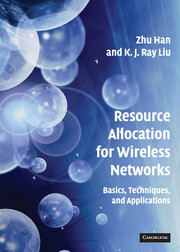3 - Power Control
from Part I - Basics Principles
Published online by Cambridge University Press: 05 August 2012
Summary
Introduction
In wireless communications, transmission power is an important resource. Power control, also known as transmit power control, is a significant design problem in modern wireless networks. Power control comprises the techniques and algorithms used to manage and adjust the transmitted power of base stations and handsets. Power control also serves several purposes, including reducing cochannel interference (CCI), managing data quality, maximizing cell capacity, minimizing handset mean transmit power, etc. In this chapter, we illustrate the basic power-control problems and some possible solutions.
In wireless communication systems, two important detrimental effects that decrease network performance are the time-varying nature of the channels and CCI. The average channel gain is primarily determined by large-scale path-loss factors such as propagation loss and shadowing. The instant channel gain is also affected by small-scale fading factors such as multipath fading. Because the available bandwidth is limited, the channels are reused for different transmissions. This channel reuse increases the network capacity per area, but, on the other hand, it causes CCI. Because of these effects, the signalto- interference-noise ratio (SINR) at a receiver output can fluctuate of the order of tens of decibels. Power control is an effective resource-allocation method to combat these detrimental effects. The transmitted power is adjusted according to the channel condition so as to maintain the received signal quality. Power control is no longer one user's problem, because a user's transmit power causes other users' interferences.
The objective of power control in wireless networks is to control the transmit power to guarantee a certain link quality and to reduce CCI.
Information
- Type
- Chapter
- Information
- Resource Allocation for Wireless NetworksBasics, Techniques, and Applications, pp. 55 - 74Publisher: Cambridge University PressPrint publication year: 2008
